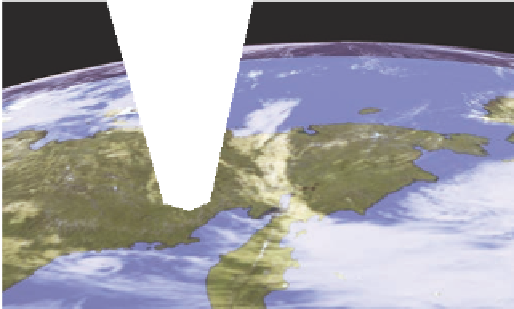Geoscience Reference
In-Depth Information
Atmospheric Pressure
the new container. In this simple example, the density of air mol-
ecules is greater in the shoebox than it is in the larger container.
You can see the effect of density on air pressure by not-
ing how pressure changes with altitude (Figure 6.2). In general,
Atmospheric circulation is an incredibly important process on
Earth for a variety of reasons. The primary impact of airflow is
to move heat energy around the globe in a way that moderates
temperature on Earth. Airflow also affects global and local air
quality and pollution levels. For example, winds can carry ash
and gases from volcanic eruptions many kilometers from the
volcano (Figure 6.1), or they can clear smog from large cities.
Similarly, dust from eroded agricultural fields can be trans-
ported great distances before it settles back to Earth. Before
we can begin to describe the nature of airflow, however, the
concept of air pressure must first be introduced because it di-
rectly influences the character of large- and small-scale wind
patterns.
As discussed in Chapter 4, the atmosphere is made up of
a variety of gases that we collectively call “air.” Like anything
else, air is held to Earth by gravity and thus has weight. The
weight of the air exerts pressure on the Earth's surface, which is
measured as
air pressure
(also called
atmospheric pressure
or
barometric pressure
).
Low density,
low pressure
Nitrogen
molecules
Oxygen
molecules
Factors That Influence Air Pressure
Atmospheric pressure is most closely associated with the tem-
perature and density of air. The concept of air density is easy to
understand if you consider that air expands or contracts depend-
ing on the environmental setting. Imagine, for example, you have
a specific number of air molecules that are contained within a
shoebox. If you can somehow move all the molecules in the shoe-
box to a larger box, the gas will expand to fit comfortably within
High density,
high pressure
Earth's
surface
Figure 6.1 Ash plume from Mount Etna in Sicily.
North-
westerly winds carry volcanic ash from the erupting volcano
toward the southeast, in an image taken on July 22, 2001,
from space station
Alpha
.
Figure 6.2 Air density, altitude, and atmospheric pres-
sure.
At low altitudes air molecules are held close to Earth
by gravity and thus are denser, resulting in high atmospheric
pressure. In contrast, the density of air molecules is low at
high altitudes, and air pressure is thus relatively low.
Air pressure
The force that air molecules exert on a surface
due to their weight.

























































































































































































